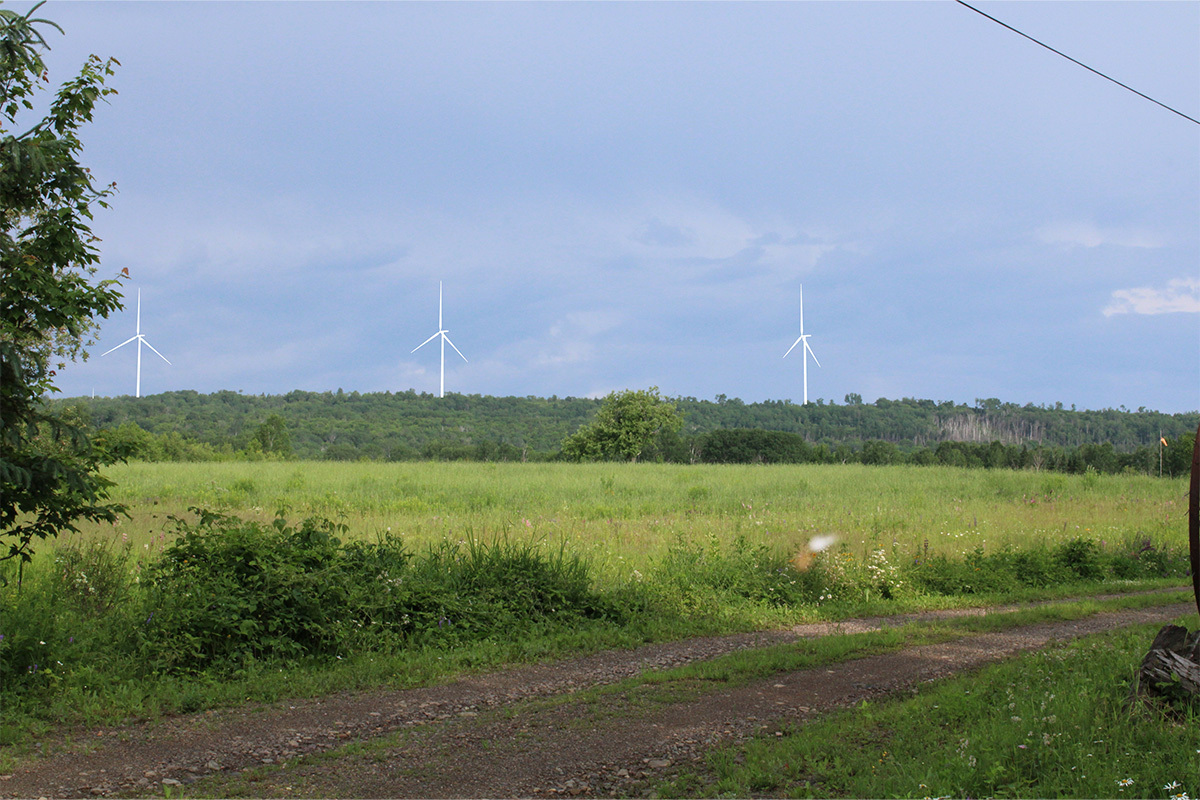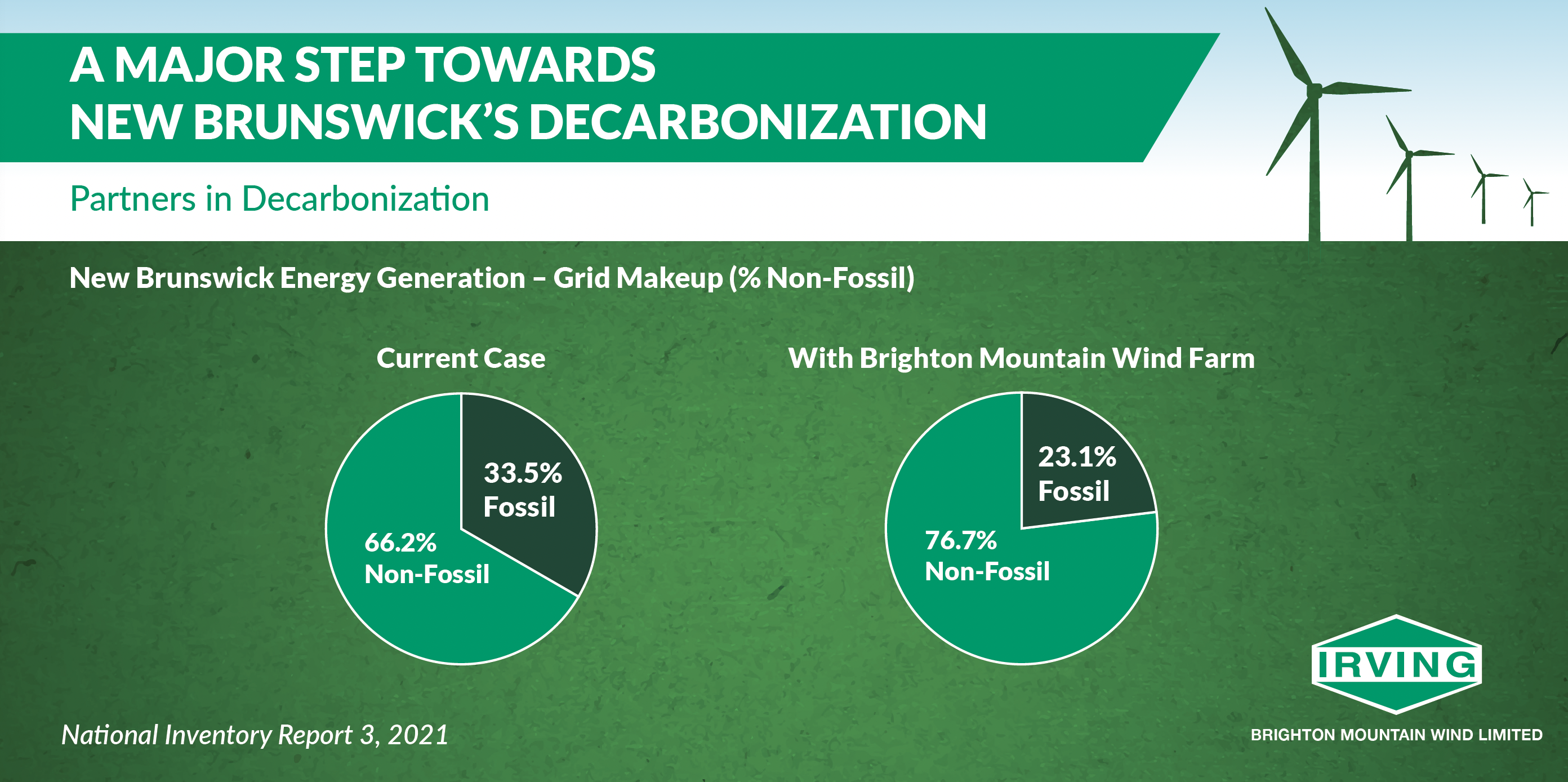
Project Overview
The Brighton Mountain Wind Farm will contribute to New Brunswick’s long-term renewable energy goals by decarbonizing the province’s electricity grid. The project will be constructed in multiple phases. The first phase will have an installed capacity of 200 megawatts with 34 wind turbines and an investment of approximately $550 million.

The first phase will have an installed capacity of 200 megawatts with an additional 150 megawatts to be added upon full project completion — enough to power the equivalent of 100,000 homes.

Created during construction.




COMMUNITY IMPACT
Location
The project will be situated near Brighton Mountain, which is south of Juniper, 26 km east of the community of Florenceville-Bristol and approximately 20 km east of the community of Hartland. It is a heavily rural, sparsely populated area with many seasonal residences.



Public Forest Access
Once construction is underway, there will be an impact to how the land is currently used. Safety signs will be posted throughout the site. Once construction is completed, there are no plans to change the way the land is used or accessed.
Wildlife Monitoring
Through our decades of research and experience, we have been committed to protecting and conserving wildlife in all areas where we operate. The project team has developed plans to protect wildlife during the construction and operational phases, and impacts will be closely monitored.


Restoration
Once construction is completed and the project is in its operational phase, stored topsoil will be placed over disturbed areas, stabilized and seeded to prevent erosion and sedimentation, while promoting regeneration, following industry standards.
Project Timeline
Brighton Mountain Wind Farm will be built on rural, heavily forested J.D. Irving, Limited timberlands south of Juniper, New Brunswick. The foundational work for phase 1 is expected to begin in 2025, pending regulatory approval. Phase 1 of the project will be complete in 2027. The second phase will add another 150 megawatts, with the timing of the second phase to be determined.

Frequently Asked Questions
View the full list of frequently asked questions for the Brighton Mountain Wind Farm project.
-
How much power will the wind farm produce?
The wind farm will produce 200 megawatts in phase 1 and 150 additional megawatts of green energy upon full project completion — enough to power the equivalent of 100,000 homes.
-
Why is J.D. Irving, Limited building a wind farm? To whom will it sell the power?
This new wind project will supply New Brunswick’s grid with more renewable energy. The power will be sold to NB Power which will contribute to decarbonizing the province. Decarbonization of the NB grid aligns with NB Power’s ‘2023 Integrated Resource Plan’ (IRP), which seeks pathways to a net-zero provincial electricity system. In addition, the greenhouse gas emissions in the New Brunswick operations of the Irving Forest Supply Chain will be indirectly reduced due to the overall decarbonization of the grid. This will help support maintaining the company's carbon neutrality.
-
How much will the project cost?
The project will be constructed in multiple phases. The first phase will be an investment of approximately $550 million.
-
Will birds and bats be impacted by turbines?
Through our decades of research and experience, we have been committed to protecting and conserving wildlife in all areas where we operate. The project team has developed plans to protect wildlife during both the construction and operational phases and impacts will be closely monitored going forward.
-
Can I still use the area for snowmobiling/hunting/hiking during and after construction?
Once construction is underway, there will be an impact to how the land is currently used. We will evaluate impacts to trails and the current level of access could be altered if required. Safety signs will be posted throughout the site where required. Once construction is completed, there are no plans to change the way the land is used or accessed.
-
Will the wind farm be loud?
As the wind turbines turn, they are expected to produce some noise in the direct vicinity of each turbine. However, the turbines will be in a remote area and most local residents will not hear them, while the closest surrounding residents will experience sound levels below acceptable limits. This has been confirmed by modelling and is well below the recommended sound criteria for wind farms.
-
Will the wind farm cause shadow flickering?
Shadow flicker occurs when the sun is low on the horizon and the rotating blades of a wind turbine periodically obstruct the sun’s rays from shining through onto a given location. The Province of New Brunswick has developed specific guidelines for wind turbines that require wind energy projects not to exceed 30 minutes/day or 30 hours/year of shadow flicker at any residence. During operation, surrounding residences will not experience shadow flicker levels at or above the regulated limits. In addition, the majority of residences will not be impacted by shadow flicker at any level due to the remote location of the turbines.
-
How far away will turbines be visible?
The turbines being considered for this project have a maximum height of 200.5m from ground level to blade tip. The visibility of the turbines is quite variable and will depend on where they are viewed from and the presence of vegetation and hills. Photomontages of local areas have been created to provide a general idea of what the landscape will look like once the project is built.
-
Will this development affect property values?
Studies on this topic find that wind turbines generally do not have any widespread, long-term impact on property values. The construction of a wind farm close (~1 mile) to residences in more populated areas can have a short-term impact on property values, however rural wind farms such as this one see no impact. The closest year-round residence to the project is greater than 1 km from any of the proposed turbine locations.
-
Why choose this location?
The proposed land is already owned and managed by Irving Woodlands. The land will continue to be managed by Irving Woodlands after the completion of the project. The project area is isolated and is not expected to impact local communities and the project area is adjacent to an existing NB Power transmission line.
-
How far away is the project located from homes?
The project will be situated near Brighton Mountain, which is south of Juniper, 26 km east of the community of Florenceville-Bristol, and approximately 20 km east of the community of Hartland.
-
Will the project create jobs?
Yes. During construction, approximately more than 200 temporary positions (direct jobs) will be created. Positions will be held by local contractors. Once construction is completed, approximately 10-14 permanent jobs will be created.
-
Where can I apply for a job in construction or at the site?
You can find all our current opportunities and apply at careers.jdirving.com. Should your application be of interest, someone from our Human Resource team will reach out to you.
-
When will construction begin? When will it be completed?
The wind farm will follow a phased development approach. The foundational work for phase 1 is expected to begin in 2025, pending regulatory approval. Phase 1 of the project will be complete in 2027.
-
Who should I talk to if I have more questions?
We invite questions and comments about our proposal. We’re committed to working with the community, our neighbours and different levels of government to develop an approach that works for everyone. If you have more questions, please email us at info@jdirving.com with the subject line: Brighton Mountain Wind Farm.
